SLVS510E July 2006 – March 2015 TPS61070 , TPS61071 , TPS61072 , TPS61073
PRODUCTION DATA.
- 1 Features
- 2 Applications
- 3 Description
- 4 Typical Application Circuit
- 5 Revision History
- 6 Device Comparison Table
- 7 Pin Configuration and Functions
- 8 Specifications
- 9 Parameter Measurement Information
- 10Detailed Description
- 11Application and Implementation
- 12Power Supply Recommendations
- 13Layout
- 14Device and Documentation Support
- 15Mechanical, Packaging, and Orderable Information
8 Specifications
8.1 Absolute Maximum Ratings
over operating free-air temperature range (unless otherwise noted)(1)| MIN | MAX | UNIT | |
|---|---|---|---|
| Input voltage on SW, VOUT, VBAT, EN, FB | -0.3 | 7 | V |
| Operating virtual junction temperature, TJ | -40 | 150 | °C |
| Storage temperature, Tstg | -65 | 150 | °C |
(1) Stresses beyond those listed under Absolute Maximum Ratings may cause permanent damage to the device. These are stress ratings only, and functional operation of the device at these or any other conditions beyond those indicated under Recommended Operating Conditions is not implied. Exposure to absolute-maximum-rated conditions for extended periods may affect device reliability.
8.2 ESD Ratings
| VALUE | UNIT | |||
|---|---|---|---|---|
| V(ESD) | Electrostatic discharge | Human-body model (HBM), per ANSI/ESDA/JEDEC JS-001(1) | ±2000 | V |
| Charged-device model (CDM), per JEDEC specification JESD22-C101(2) | ±750 | |||
(1) JEDEC document JEP155 states that 500-V HBM allows safe manufacturing with a standard ESD control process. Manufacturing with less than 500-V HBM is possible with the necessary precautions.
(2) JEDEC document JEP157 states that 250-V CDM allows safe manufacturing with a standard ESD control process. Manufacturing with less than 250-V CDM is possible with the necessary precautions.
8.3 Recommended Operating Conditions
| MIN | NOM | MAX | UNIT | |
|---|---|---|---|---|
| Supply voltage at VBAT, VI (TPS61070, TPS61071, TPS61072) | 0.9 | 5.5 | V | |
| Supply voltage at VBAT, VI (TPS61073) | 2.3 | 5.5 | V | |
| Operating free air temperature range, TA | -40 | 85 | °C | |
| Operating virtual junction temperature range, TJ | -40 | 125 | °C |
8.4 Thermal Information
| THERMAL METRIC(1) | TPS6107x | UNIT | |
|---|---|---|---|
| DDC | |||
| 6 PINS | |||
| RθJA | Junction-to-ambient thermal resistance | 139.1 | °C/W |
| RθJC(top) | Junction-to-case (top) thermal resistance | 34.8 | |
| RθJB | Junction-to-board thermal resistance | 42.5 | |
| ψJT | Junction-to-top characterization parameter | 1.4 | |
| ψJB | Junction-to-board characterization parameter | 40.7 | |
| RθJC(bot) | Junction-to-case (bottom) thermal resistance | n/a | |
(1) For more information about traditional and new thermal metrics, see the IC Package Thermal Metrics application report, SPRA953.
8.5 Electrical Characteristics
over recommended free-air temperature range and over recommended input voltage range (typical at an ambient temperature range of 25°C) (unless otherwise noted)8.6 Typical Characteristics
8.6.1 Table of Graphs
| FIGURE | |||
|---|---|---|---|
| Maximum output current | vs Input voltage | Figure 1 | |
| Efficiency | vs Output current | Figure 2 | |
| vs Output current | Figure 3 | ||
| vs Output current | Figure 4 | ||
| vs Input voltage | Figure 5 | ||
| vs Input voltage | Figure 6 | ||
| Output voltage | vs Output current | Figure 7 | |
| vs Output current | Figure 8 | ||
| No load supply current into VOUT | vs Input voltage | Figure 9 | |
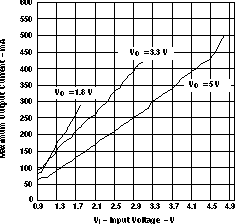 Figure 1. Maximum Output Current vs Input Voltage
Figure 1. Maximum Output Current vs Input Voltage
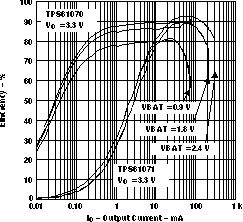 Figure 3. Efficiency vs Output Current
Figure 3. Efficiency vs Output Current
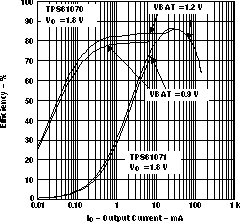 Figure 2. Efficiency vs Output Current
Figure 2. Efficiency vs Output Current
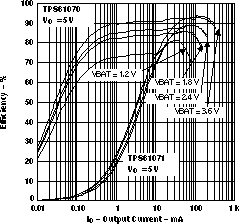 Figure 4. Efficiency vs Output Current
Figure 4. Efficiency vs Output Current
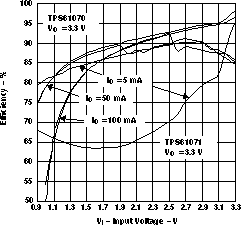 Figure 5. Efficiency vs Input Voltage
Figure 5. Efficiency vs Input Voltage
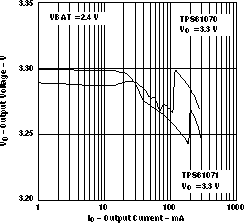 Figure 7. Output Voltage vs Output Current
Figure 7. Output Voltage vs Output Current
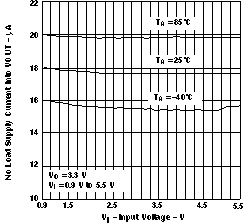 Figure 9. No Load Supply Current Into VOUT vs Input Voltage
Figure 9. No Load Supply Current Into VOUT vs Input Voltage
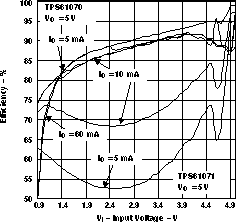 Figure 6. Efficiency vs Input Voltage
Figure 6. Efficiency vs Input Voltage
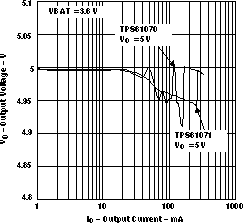 Figure 8. Output Voltage vs Output Current
Figure 8. Output Voltage vs Output Current